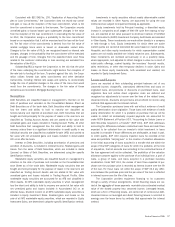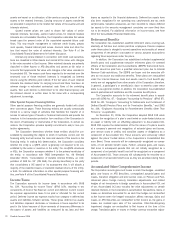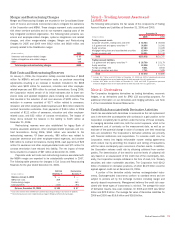Bank of America 2006 Annual Report Download - page 106
Download and view the complete annual report
Please find page 106 of the 2006 Bank of America annual report below. You can navigate through the pages in the report by either clicking on the pages listed below, or by using the keyword search tool below to find specific information within the annual report.On January 1, 2006, Bank of America Corporation and its subsidiaries (the
Corporation) acquired 100 percent of the outstanding stock of MBNA
Corporation (MBNA). On April 1, 2004, the Corporation acquired all of the
outstanding stock of FleetBoston Financial Corporation (FleetBoston). Both
mergers were accounted for under the purchase method of accounting.
Consequently, both MBNA and FleetBoston’s results of operations were
included in the Corporation’s results from their dates of acquisition.
The Corporation, through its banking and nonbanking subsidiaries,
provides a diverse range of financial services and products throughout the
U.S. and in selected international markets. At December 31, 2006, the
Corporation operated its banking activities primarily under two charters:
Bank of America, National Association (Bank of America, N.A.) and FIA
Card Services, N.A. Bank of America, N.A. was the surviving entity after the
merger of Fleet National Bank on June 13, 2005. Effective June 10, 2006,
MBNA America Bank N.A. was renamed FIA Card Services, N.A., and on
October 20, 2006, Bank of America, N.A. (USA) merged into FIA Card Serv-
ices, N.A. These mergers had no impact on the Consolidated Financial
Statements of the Corporation.
Note 1 – Summary of Significant Accounting
Principles
Principles of Consolidation and Basis of Presentation
The Consolidated Financial Statements include the accounts of the Corpo-
ration and its majority-owned subsidiaries, and those variable interest enti-
ties (VIEs) where the Corporation is the primary beneficiary. All significant
intercompany accounts and transactions have been eliminated. Results of
operations of companies purchased are included from the dates of acquis-
ition. Assets held in an agency or fiduciary capacity are not included in the
Consolidated Financial Statements. The Corporation accounts for invest-
ments in companies in which it owns a voting interest of 20 percent to 50
percent and for which it has the ability to exercise significant influence
over operating and financing decisions using the equity method of account-
ing. These investments are included in Other Assets and the Corporation’s
proportionate share of income or loss is included in Equity Investment
Gains.
The preparation of the Consolidated Financial Statements in con-
formity with accounting principles generally accepted in the United States
(GAAP) requires management to make estimates and assumptions that
affect reported amounts and disclosures. Actual results could differ from
those estimates and assumptions. Certain prior period amounts have
been reclassified to conform to current period presentation.
Recently Issued or Proposed Accounting
Pronouncements
On February 15, 2007, the Financial Accounting Standards Board (FASB)
issued Statement of Financial Accounting Standards (SFAS) No. 159, “The
Fair Value Option for Financial Assets and Financial Liabilities” (SFAS
159), which allows an entity the irrevocable option to elect fair value for
the initial and subsequent measurement for certain financial assets and
liabilities on a contract-by-contract basis. Subsequent changes in fair value
of these financial assets and liabilities would be recognized in earnings
when they occur. SFAS 159 further establishes certain additional dis-
closure requirements. SFAS 159 is effective for the Corporation’s financial
statements for the year beginning on January 1, 2008, with earlier adop-
tion permitted. Management is currently evaluating the impact and timing
of the adoption of SFAS 159 on the Corporation’s financial condition and
results of operations.
On September 29, 2006, the FASB issued SFAS No. 158,
“Employers’ Accounting for Defined Benefit Pension and Other Postretire-
ment Plans, an amendment of FASB Statements No. 87, 88, 106, and
132(R)” (SFAS 158), which requires the recognition of a plan’s over-
funded or under-funded status as an asset or liability with an offsetting
adjustment to Accumulated Other Comprehensive Income (OCI). SFAS 158
further requires the determination of the fair values of a plan’s assets at a
company’s year-end and recognition of actuarial gains and losses, prior
service costs or credits, and transition assets or obligations as a compo-
nent of Accumulated OCI. This statement was effective as of
December 31, 2006. The adoption of SFAS 158 reduced Accumulated OCI
by approximately $1.3 billion after tax in 2006.
On September 15, 2006, the FASB issued SFAS No. 157, “Fair Value
Measurements” (SFAS 157). SFAS 157 defines fair value, establishes a
framework for measuring fair value under GAAP and enhances disclosures
about fair value measurements. SFAS 157 defines fair value as the
exchange price that would be received for an asset or paid to transfer a
liability (an exit price) in the principal or most advantageous market for the
asset or liability in an orderly transaction between market participants on
the measurement date. SFAS 157 is effective for the Corporation’s finan-
cial statements issued for the year beginning on January 1, 2008, with
earlier adoption permitted. Management is currently evaluating the impact
and timing of the adoption of SFAS 157 on the Corporation’s financial
condition and results of operations.
On September 13, 2006, the Securities and Exchange Commission
(SEC) issued Staff Accounting Bulletin (SAB) No. 108 “Considering the
Effects of Prior Year Misstatements when Quantifying Misstatements in
Current Year Financial Statements” (SAB 108). SAB 108 expresses the
SEC Staff’s views regarding the process of quantifying financial statement
misstatements. SAB 108 states that in evaluating the materiality of finan-
cial statement misstatements, a corporation must quantify the impact of
correcting misstatements, including both the carryover and reversing
effects of prior year misstatements, on the current year financial state-
ments. SAB 108 is effective for the year ended December 31, 2006. The
application of SAB 108 did not have an impact on the Corporation’s finan-
cial condition and results of operations.
On July 13, 2006, the FASB issued FASB Staff Position (FSP) No. FAS
13-2, “Accounting for a Change or Projected Change in the Timing of Cash
Flows Relating to Income Taxes Generated by a Leveraged Lease Trans-
action” (FSP 13-2). The principal provision of FSP 13-2 is the requirement
that a lessor recalculate the recognition of lease income when there is a
104
Bank of America 2006
Notes to Consolidated Financial Statements
Bank of America Corporation and Subsidiaries
























